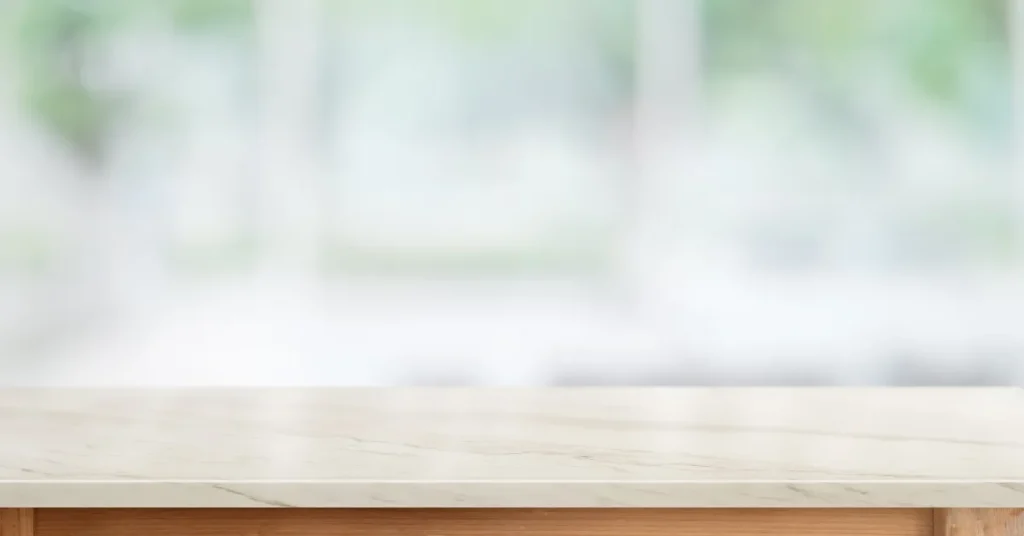A standard table top should be at least 1 inch thick. Thicker tops, up to 3 inches, are ideal for large or heavy-duty tables.
Selecting the proper thickness for a table top is crucial for both aesthetic appeal and functionality. The thickness impacts the table’s sturdiness, durability, and overall look. Homeowners and interior designers often choose a thickness that complements the table’s style and intended use.
Commercial settings, such as restaurants and offices, might opt for thicker tops to withstand frequent use and wear. On the other hand, thinner table tops can be perfect for small spaces or as elegant, lighter pieces in a room.
Careful consideration of the table’s role in a space ensures that the chosen thickness not only enhances the design but also serves its purpose effectively.
Remember, the best thickness for your table will align with its expected use, style preferences, and the scale of the room it inhabits.

Introduction To Table Top Thickness
Choosing the correct table top thickness is essential to table design and functionality. Thickness affects durability, aesthetics, and usage. It’s not just a matter of personal taste, but also practical application. This section explores key considerations to ensure your table is just right for your space.
Factors Influencing Thickness Choices
Different elements play a part in determining the ideal tabletop thickness:
- Material: Wood, glass, and stone have varying density and strength.
- Size and Support: Larger tables require thicker tops for stability.
- Function: Eating, working, or heavy use dictate durability needs.
- Style: Thin tops seem modern, while thicker tops appear traditional.
The Role Of Table Top Thickness
Thickness isn’t just about looks; it significantly affects a table’s role:
| Thickness | Pros | Cons |
| Thin (≤¾ inch) | Lightweight, sleek, suits contemporary styles | Can lack strength for heavy use |
| Medium (1–1½ inches) | Offers balance between strength and aesthetics | Not as robust as thicker tops |
| Thick (>1½ inches) | Highly durable, classic appearance, supports heavy objects | Heavier, challenging to move, costly |
A careful assessment of these aspects ensures the table top you choose meets your needs and complements your space.
Materials And Their Influence On Thickness
Selecting the right thickness for a table top is crucial. It defines stability, durability, and aesthetics.
Different materials require their individual considerations for thickness. This ensures both longevity and a pleasing design. Let’s delve into the specifics of each material.
Wooden Table Top Considerations
Wood varies in density and strength. These traits affect the necessary thickness for stability. Here’s a quick guide:
- Softwoods: Require more thickness.
- Hardwoods: Thicker than veneers but can be slimmer than softwoods.
- Veneers: Thinnest option, often on a sturdy substrate.
Dining tables and desks typically require tops that are 1-1/4 inches to 2-1/4 inches thick.
Glass Table Strength And Dimensions
Glass tables offer a modern look. They need careful consideration for thickness related to safety. Common thicknesses include:
| Use | Recommended Thickness |
| Small Tables | 1/4 inch |
| Coffee Tables | 3/8 inch to 1/2 inch |
| Dining Tables | 1/2 inch to 3/4 inch |
Always opt for tempered glass for added strength and safety.
Metal Table Top Specifications
Metal tables are robust and versatile. Here’s what to keep in mind:
- Aluminum: Lightweight, yet sturdy, ideal for casual settings.
- Steel: Heavier, often found in industrial designs.
Thickness for metal tops typically varies from 1/16 inch to 1/4 inch, depending on use and design.
Standard Thickness For Various Table Types

Choosing the ideal table top thickness can impact both aesthetics and functionality. Various tables serve different purposes and thus require specific thicknesses. Below, discover standard measurements tailored to each type of table.
Dining Tables
Dining tables blend practicality with style. An average dining table measures 0.75 to 1 inch thick. Durability matters for these frequently used pieces. Thicker tops, up to 1.5 inches, denote luxury and strength.
Coffee Tables
Coffee tables offer a focal point in living spaces. A standard thickness for these tables is about 0.75 inches. Sleek designs often feature slender tops, while robust styles may reach 1 inch.
Office Desks
Office desks withstand daily wear and tear. They commonly measure 1 to 1.5 inches thick. Thicker desks suggest stability and can support significant weight.
Kitchen Countertops
Kitchen countertops require resilience. Standard countertop thickness is 1.25 inches. This ensures they can cope with the demands of kitchen tasks while maintaining a sleek appearance.
Considerations such as material properties and intended use guide the selection process for table top thickness. Whether it’s a dining area centerpiece or a sturdy office workstation, choosing the right thickness ensures lasting enjoyment and use.
Custom Thickness Solutions
Choosing the right table top thickness is crucial for functionality and aesthetics. Custom Thickness Solutions tailors to specific needs and preferences. Whether seeking robustness or sleek elegance, options are plentiful.
When To Consider Thicker Tops
A sturdy, thick table top makes a statement. It’s perfect for:
- High Traffic Areas: Durability is key.
- Large Tables: Thicker tops prevent sagging.
- Industrial Looks: They add heft and presence.
Materials like hardwood or reinforced glass are ideal. Consider thicknesses over 1.5 inches for these scenarios.
Strategies For Thinner Table Tops
Thinner tops bring a modern feel. Achieve this look with:
- Supportive Bases: Ensure stability.
- Lighter Materials: Aluminum or acrylic.
- Bracing Techniques: Under-table supports.
Go for tops around 0.75 inches to maintain elegance without sacrificing strength.
Measuring And Adjusting Table Top Thickness
Determining optimal table top thickness depends on function and design. Typical thickness ranges from ¾-inch to 1 ½ inches, ensuring stability and aesthetic appeal. Adjustments can be made for custom projects to suit individual needs and preferences.
Understanding the ideal thickness for a table top is crucial for both aesthetics and functionality. The right thickness will ensure durability, stability, and a pleasing visual balance.
A range of factors, including material type, table size, and intended use, influence this decision. Luckily, with the right methods and a few adjustments, anyone can find the perfect fit for their furniture piece.
Tools And Techniques
Essential measuring tools are key to determining an appropriate table top thickness. Equip yourself with a:
- Tape measure: For length and width dimensions
- Caliper: To gauge smaller thicknesses precisely
- Straight edge: Ensures evenness across the surface
Begin by measuring the current thickness at several points to ensure uniformity. If inconsistencies arise, sanding may be necessary to achieve a level surface.
Diy Table Top Projects
DIY enthusiasts can take on table top creation with confidence. Start with selecting a wood slab. Ensure it’s flat and free of large defects. Here’s a quick guide on adjusting thickness:
- Measure and mark the desired thickness.
- Use a planer to slowly remove excess wood.
- Sand the surface for a smooth finish.
Remember, most wooden table tops should be at least 3/4 inch thick to maintain stability. For larger tables, consider thicker tops up to 1 1/2 inches.
Professional Customization Tips
A professional’s touch can turn good into great. Consult seasoned woodworkers for intricate designs or heavy materials.
They have the expertise to recommend the ideal thickness based on your table’s framework and usage. Expect a blend of artistry and engineering for an impeccable finish.
They may use advanced tools such as a CNC router for precision cuts or joinery techniques to add strength. Trust a professional for a unique, custom table top that stands the test of time.
Maintenance And Care Based On Thickness

Table tops vary in thickness, and each demands unique maintenance strategies. Thicker tops often mean sturdier surfaces, while thinner ones can be more delicate.
Knowing how to care for your table based on its thickness is key to ensuring its longevity and visual appeal.
Protecting Your Table Top
Protecting a table top starts with day-to-day actions to prevent damage. No matter the thickness, there are simple habits to adopt for safeguarding your table:
- Use coasters to prevent water rings.
- Place mats serve as a barrier against scratches.
- Avoid direct sunlight, which can cause warping or fading.
Repair And Upkeep
Scratches and dings can happen, but thinner table tops may need more gentle care. Follow these tips:
- For minor scratches, use a matching wood marker.
- Thicker tops can handle sanding and refinishing.
- Always consult a professional for deep repairs.
Longevity And Durability Considerations
Thicker tables often last longer due to their robust nature. Here’s how to enhance durability:
- Treat wood with sealants to resist moisture.
- For heavy use, choose hardwoods like maple or oak.
- Maintain stable humidity levels to avoid wood expansion.
Different thicknesses may require unique approaches, but consistent care ensures your table top remains a focal point in your space for years to come.
FAQs About How Thick Should A Table Top Be
How Thick Should I Make A Table Top?
A table top should generally be at least 3/4 inch thick for stability. Thicker tops, up to 1 1/4 inches, offer more durability for frequent use.
Is 3 4 Thick Enough For A Table?
A 3/4 inch thickness is generally sufficient for a table, providing a durable and stable surface for everyday use.
How Thick Should Dining Room Table Be?
A typical dining room table should have a top thickness between 0. 75 inches and 1 inch. Optimal thickness can vary based on material and design.
What Wood Is Best For Table Top?
Hardwoods like maple, oak, walnut, and cherry are often preferred for table tops due to their durability and aesthetic appeal.
Conclusion
Selecting the ideal thickness for your table top balances aesthetics and function. A thickness of 3/4″ to 1 1/4″ typically meets most needs.
Personal preference, application, and material play key roles in your choice. Ensure durability and style align with your vision for a table that stands the test of time.
Resources:
1. https://diningservices.wustl.edu/home/table-top-displays/
